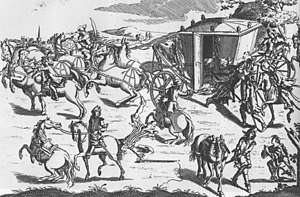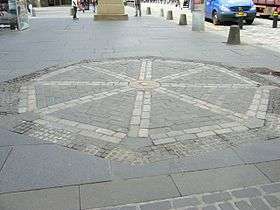David Hackston
David Hackston or Halkerstone (died 30 July 1680), was a militant Scottish Covenanter, remembered mainly for his part in the murder of Archbishop James Sharp of St. Andrews in 1679 and his involvement in the events of 1680 which led to his capture and execution.

Biography
Hackston belonged to a well-connected landowning family, the Hackstons or Halkerstones of Rathillet, in the parish of Kilmany, Fifeshire. He was the eldest son of James Hackston and Margaret, daughter of James Falconer of Craigfoodie, and inherited his father's estate in 1670.[1] According to a parish minister writing in 1845, "It is not known whether he was born at the family seat. The records of the kirk-session do not go back so far".[2] There is no indication that he was religious in his youth, but attendance at a 'field preaching' led him to cast in his lot with the Covenanters, becoming one of their most trusted leaders.[3]
In 1679 he was asked to lead the party which had resolved to assassinate Archbishop Sharp, but declined "upon account of a difference subsisting betwixt Sharp and him in a civil process, wherein he judged himself to have been wronged by the primate, which deed he thought would give the world ground to think it was rather out of personal pique and revenge, which he professed he was free of".[4] He agreed, however, to stand by the others and take the consequences. Accordingly, he sat at some distance from the action, while other members of the group, led by John Balfour of Kinloch, despatched Sharp on 3 May 1679.[5]
One of the group, James Russell, later stated that one of Sharp's servants, "came to Rathillet, who was standing at a distance with his cloak about his mouth all the time on horseback, and desired him to come and cause save his life, who answered, as he meddled not with them nor desired them to take his life, so he durst not plead for him nor forbid them".[6]
After the murder Hackston fled into the west country and took part in drawing up and publishing The Declaration and Testimony of the true Presbyterian Party in Scotland, which condemned the government's actions in religious affairs since the Restoration. On 29 May 1679, on the day chosen to celebrate the anniversary of the King's return to the throne, a party of Covenanters, Hackston among them, rode into Rutherglen, extinguished the bonfire in the main street and read the Declaration publicly before affixing it to the mercat cross.[3] A new fire was then lit and Acts of Parliament and the Privy Council passed against the Covenanters since 1660 were consigned to the flames.[7]
Hackston was also one of the commanders of the Covenanters who fought at the battle of Drumclog on 1 June, and again at Bothwell Bridge on 22 June 1679 where he was credited with heroically defending the bridge for up to an hour against superior forces led by the Duke of Monmouth. Having escaped from the battlefield, a reward of 10,000 merks was offered for his apprehension, obliging him to stay in hiding.[3][lower-alpha 1]
In July 1680 he reappeared as one of the armed followers who accompanied Richard Cameron at the issuing of the Sanquhar Declaration.[5] At length, on 22 July 1680, he and about 60 of Cameron's followers were surprised by a body of dragoons at Airds Moss in Ayrshire. A skirmish ensued in which the Covenanters were worsted, and Hackston, apparently in the capacity of commander-in-chief and badly wounded, was taken prisoner and escorted to Edinburgh.[5] The Privy Council instructed that:
The magistrates of Edinburgh are appointed, as soon as the body of David Hackston of Rathillet is brought to the Water Gate, to receive him, and mount him on a bare-backed horse, with his face to the horse's tail, and his feet tied beneath his belly, and his hands flightered with ropes; and the executioner, with head covered, and his coat, lead his horse up the street to the Tolbooth, the said Hackston being bareheaded; that the three other prisoners be conveyed on foot, bareheaded, after him, with their hands tied to a goad of iron; ordain the said executioner to carry the head of Cameron on a halbert, from the Water Gate to the Council House.
— Privy Council.[8]

Then, following a hearing before the Privy Council, at which he was indicted for the murder of Sharp, he appeared before the Justiciary and again before the Council which pronounced sentence, ordaining:
That his body be drawn backward on a hurdle to the Mercat Cross; that there be a high scaffold erected a little above the Cross, where, in the first place, his right hand is to be struck off and, after some time, his left hand; then he is to be hanged up, and cut down alive, his bowels to be taken out, and his heart shown to the people by the hangman; then his heart and his bowels to be burned in a fire prepared for that purpose on the scaffold; that, afterwards, his head be cut off, and his body divided into four quarters; his head to be fixed on the Netherbow; one of his quarters with both his hands to be affixed at St. Andrews, another quarter at Glasgow, a third at Leith, a fourth at Burntisland; that none presume to be in mourning for him, or any coffin brought; that no person be suffered to be on the scaffold with him, save the two bailies, the executioner and his servants; that he be allowed to pray to God Almighty, but not to speak to the people; that Hackston's and Cameron's heads be fixed on higher poles than the rest.
— Privy Council.[9]
The execution took place on 30 July 1680. It seems that Hackston had a strong constitution, because, despite the loss of his hands and the disembowelling, it was claimed that his heart continued to beat for some time after it was on the executioner's knife.[10]
Notes
- Clearly a huge amount at the time, though perhaps not as much as it seems at first sight. An English contemporary tried to explain the value of Scots money to his compatriots thus, "Their money is commonly dollars, or mark-pieces, coined at Edinburgh, but the way of reckoning is surprising to a stranger. To receive a bill of £100 in one of their change-houses, where one would not suppose they had any of the value of a hundred pence; they call a penny a shilling, and every twenty shillings, viz., twenty pence, a pound; so the proportion of their pound to ours is twelve to one. Strangers are sure to be grossly imposed upon in all their change-houses, and there is no redress for it. If an Englishman should complain to their magistrates, they would all take a part against them, and make sure to squeeze him." -- A Modern Account of Scotland by an English Gentleman [Thomas Kirke?] London 1679
- McCall, Hardy Bertram (1890). Some Old Families. Watson & Ball. p. 37–38.
- Hamilton 1890, p. 423 cites New Statistical Account of Scotland, ix. 539
- Hamilton 1890, p. 423.
- Howie 1870, p. 430.
- Muir 2004.
- Sharpe 1817, p. .
- http://www.historic-scotland.gov.uk/battle_of_drumclog_summary.pdf
- Wodrow, p. 141.
- Smellie 1911, p. 340.
- Thomson 1871, p. 39.
References
- Howie, J (1870), The Scots Worthies, Edinburgh and London
- Muir, Alison G. (2004). "Hackston , David, of Rathillet (d. 1680)". Oxford Dictionary of National Biography (online ed.). Oxford University Press. doi:10.1093/ref:odnb/11843. (Subscription or UK public library membership required.)
- Sharpe, C. K., ed. (1817), Kirkton, Secret and True History of the Church of Scotland, Edinburgh
- Smellie, A (1911), Men Of The Covenant, London, p. 340
- Thomson, John Henderson, ed. (1871), A cloud of witnesses, for the royal prerogatives of Jesus Christ: or, The last speeches and testimonies of those who have suffered for the truth in Scotland, since 1680, Edinburgh: Johnston Hunter and Company, p. 39
- Wodrow, R, The History of the Sufferings of the Church of Scotland from the Restoration to the Revolution, 1721-22, ii, p. 141
- Attribution

Further reading
- Pringle, J (1914), Thomson, The Scottish Covenanters 1637-1688, London contains a detailed account of Sharp's murder.
- Yeoman, L (2000), Reportage Scotland, Edinburgh contains Hackston's own account of his part in the fight at Airds Moss.
- The account of James Russell who took part in the murder
- Paterson, R C (1998), A Land Afflicted, Scotland And The Covenanter Wars, 1638-1690, Edinburgh